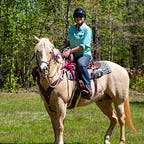Rabbit, Rabbit
Cuteness, and a bit of grossness too
I recently learned that you should say, “Rabbit Rabbit!” out loud as your first words on the first day of each month. This brings 30 days of good luck, so they say. I never remember; so much for my luck. But the little brown rabbit that I keep seeing in the driveway must be doing something. I don’t see how that little guy stays alive with the cars, dogs, and coyotes he has to outwit.
Wild rabbits are here year-round, but I see them more often in the cold months when the lush green of Alabama recedes to reveal her horde of winter treasures including critters like rabbits who are out in abundance, scouting for food. Although rabbits are considered nuisances by many, I am charmed by their cuteness and feel lucky indeed whenever I spot one. If you want to see wild rabbits, look around in the evening and at night when they are most likely to be out.
When I was little, my neighbor’s pet rabbit had babies. Next thing you know every kid in the neighborhood had a rabbit; I was no exception. I chose a black and white bunny who fit into my hand and named him Daffodil. He grew to be big and strong, and had a kick that left a mark, but he could also be sweet and cuddly. I used to lie on the floor, eye level to his face and watch his twitchy nose move in little circles when he chewed. He chewed a lot.
Daffodil was my one and only pet rabbit, and to be honest, I don’t know a whole lot about these big eared beasts. To celebrate the little cottontail who’s making his appearance in our yard lately, I thought I’d brush up on my bunny facts, and of course, share with you.
What are rabbits, taxonomically speaking? They are in the order Lagomorpha, which includes two families: Leporidae (rabbits and hares) and Ochotonidae (pikas). Up until 1912 they were classified in the order Rodentia, but were reclassified based on several distinctions including two extra incisors their rodent friends lack.
Of the 29 species of rabbits, four found here in Alabama: the swamp rabbit, the eastern cottontail, the Appalachian cottontail, and the marsh rabbit. Eastern cottontails are the most abundant, and are found throughout the state. As their names indicate, swamp and marsh rabbits live in riparian, watery places, and Appalachian cottontails typically reside in high elevations, with only a few sited in Alabama. This leads me to conclude that the rabbit who visits our yard is an eastern cottontail.
Why “cottontail”? Unlike other rabbits, their tails are white on top. As with deer, the evolutionary advantage of this bit of white is the ability to confuse predators as they zig and zag their way to safety.
We all know rabbits breed like rabbits. A single pair of eastern cottontails can theoretically give rise to 350,000 descendants in 5 years. Why then are we not swimming in bunnies? Rabbits have a short life span (3 years) and a high mortality rate, with about 50% dying before leaving the nest. With predators at every hop, mother rabbits (does) try their best to keep their nests secret, visiting them only twice a day. Even then, the doe doesn’t fully enter the nest but stands over it to feed her babies, who are not technically bunnies but kits or kittens.
Rabbits have excellent vision, hearing, and smell, and are always on the alert for predators. With eyes set out and to the side, they have a 350-degree field of vision with a small blind spot directly in front of them. As for that adorable twitching nose I referred to earlier, this is how rabbits expose their scent receptors, of which they have about a million. It wasn’t my imagination that Daffodil was busy twitching; rabbits twitch their noses up to 120 times a minute.
If you’ve made it this far in this fact-filled column, brace yourself for the best, or worst, bit of all. Rabbits engage in coprophagia, that is, eating their own feces. They don’t eat the little round rabbit pellets; rather, they ingest a special kind of feces called cecotropes, which is softer and chock-full of nutrients. You won’t catch a rabbit doing this as they eat the cecotropes immediately as it exits the body, and it only happens at night.
I’m not sure what I’ll do with my new knowledge of eastern cottontails. As for you, you can take an online quiz I created just for you! Go to “Kahoot.It” on your computer or phone, and put in this game PIN: 008547441. From there you can create a nickname and start the fun! Best of luck to you all, and no peeking back at the article.
Rabbit Rabbit!
Mary Dansak is a writer and a retired science education specialist living in Auburn, AL. She can be reached at maryfdansak@gmail.com.
